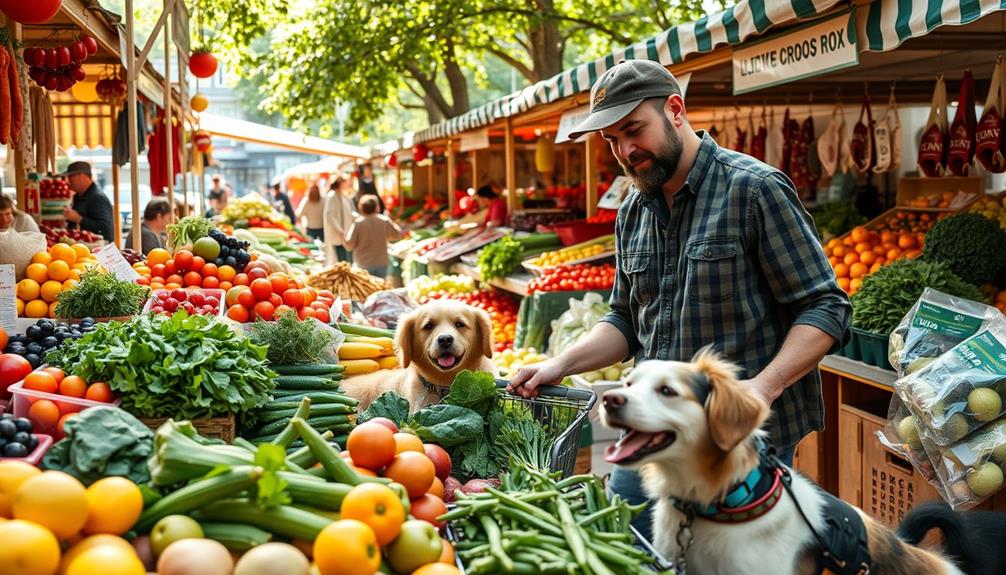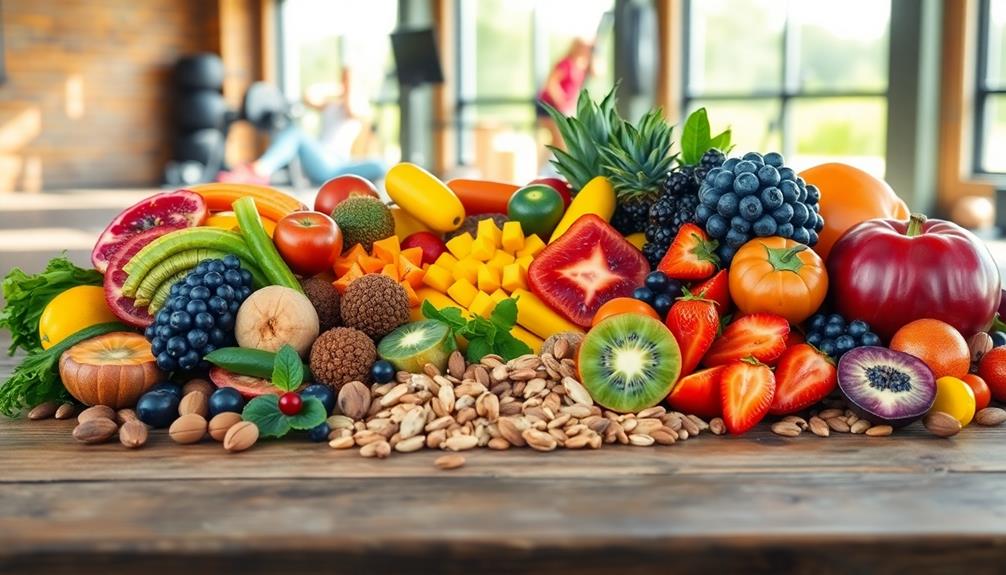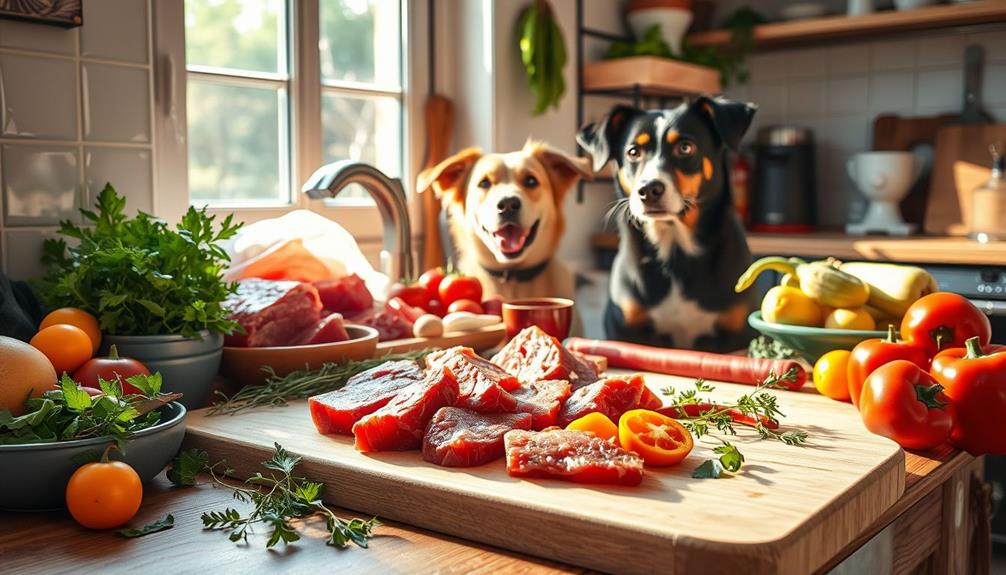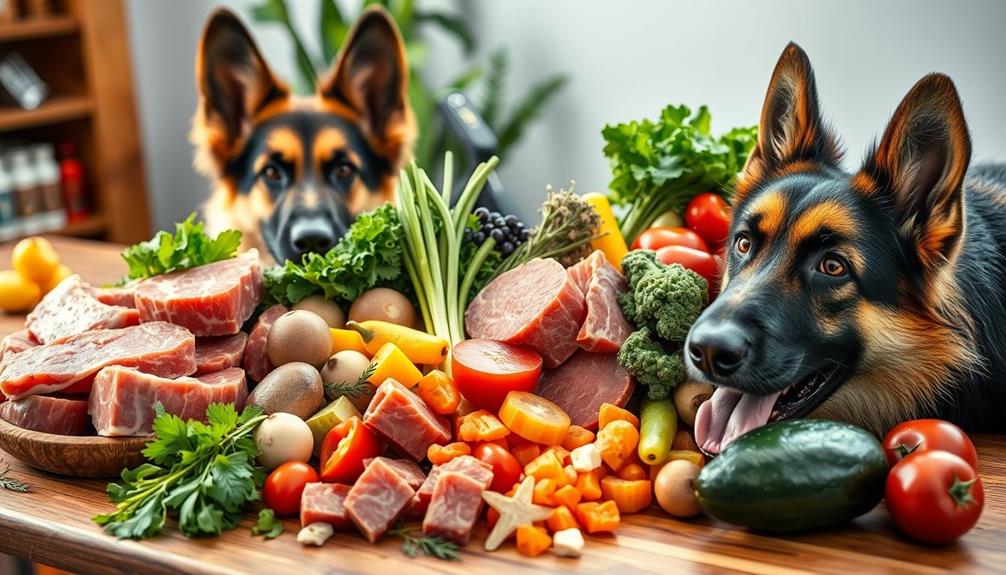You can get raw food for dogs from several great sources. Local pet stores usually have a freezer section with various brands, and independent shops often stock healthier options. Grocery stores and specialty markets offer unique proteins and organ meats, while local farmers and butchers provide fresher, organic selections. Online retailers and subscription services make it easy with home delivery of high-quality food tailored to your dog's needs. Joining raw feeding co-ops can also help save costs and connect you with other dog owners. Stick around to discover more ways to keep your furry friend nourished and happy!
Key Takeaways
- Visit local pet stores for a variety of ethically sourced raw dog food and additional ingredients like fruits and vegetables.
- Explore grocery stores and specialty markets for unique proteins, organ meats, and bulk purchasing options for cost-effective raw feeding.
- Check with butchers and meat suppliers for diverse cuts, organ meats, and raw meat scraps to enhance your dog's diet.
- Purchase from local farmers for fresher, organic meat options and to support ethical animal raising practices within the community.
- Utilize online retailers and subscription services for convenient home delivery, wider product variety, and potential savings on bulk orders.
Brick & Mortar Pet Stores
When you're looking for raw dog food, brick-and-mortar pet stores can be a great option. Many of these stores have freezer sections stocked with various brands, making it convenient for you to find what you need.
While larger franchises like PetCo and PetSmart offer some raw dog food, they often have a limited selection. Instead, consider visiting independently owned pet stores, which typically stock healthier brands with higher nutritional value and a wider variety of options.
These stores often prioritize financial considerations for elderly care when sourcing products, ensuring quality and ethical standards. You might discover regional favorites among the raw dog food offerings that cater to your area's preferences.
These local pet stores often source their products from local farms, ensuring that the ingredients are ethically sourced. Not only can you find raw dog food, but these stores can also be a one-stop shop for additional ingredients, like herbs, fruits, and vegetables, to complement your dog's diet.
Grocery Stores & Specialty Markets
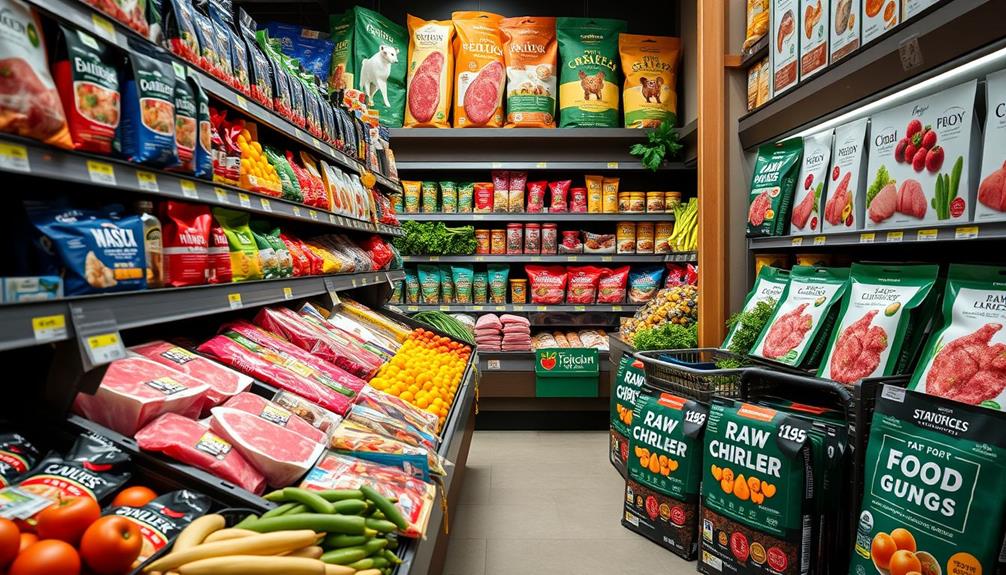
Grocery stores and specialty markets have stepped up their game, making it easier than ever to find raw food options for your dog. Many regular grocery chains now feature freezers dedicated to raw or cooked meals for pets, providing more choices right in your neighborhood. Specialty markets take it a step further, often stocking unique proteins and organ products not typically found in standard stores.
When exploring the less-trafficked meat sections of grocery stores, you might discover organ meats like liver, heart, and gizzards—rich in essential nutrients for your dog's diet. Local farmers markets can also be a treasure trove, offering fresher meat options, including grass-fed, organic, and humanely raised varieties.
If you're looking to save some bucks, consider bulk purchasing from these grocery stores or specialty markets. It can yield better deals and make raw feeding a more cost-effective option.
| Grocery Stores | Specialty Markets |
|---|---|
| Limited raw options | Unique proteins |
| Organ meats available | Fresh, diverse choices |
| Cost-effective bulk | Quality over quantity |
| Convenient locations | Expert advice |
Butchers and Meat Suppliers
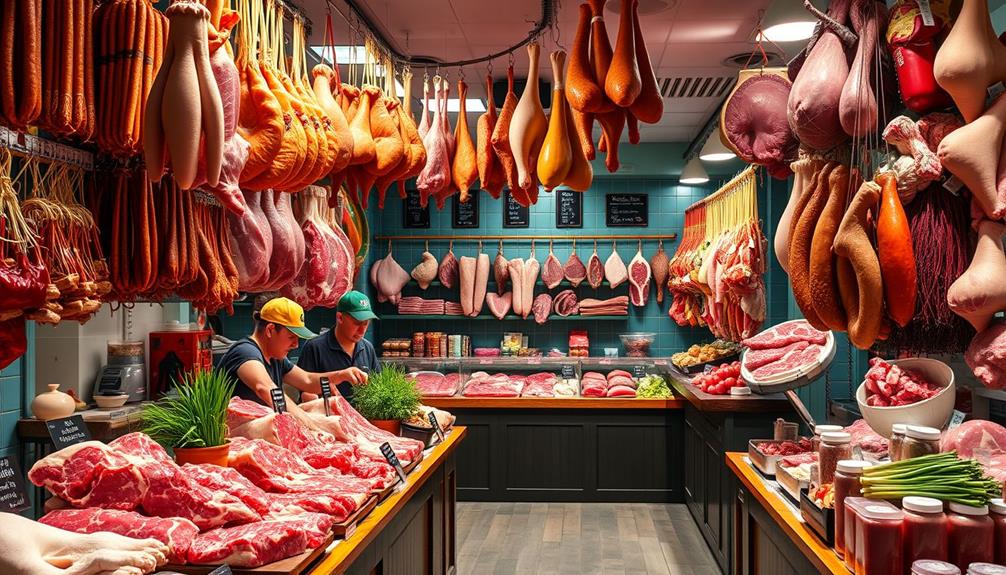
Butchers and meat suppliers offer a treasure trove of protein options perfect for your dog's raw food diet. When you choose to source your dog's meals from these experts, you're opening up a world of nutritious and diverse protein choices.
Additionally, sourcing high-quality ingredients can enhance your dog's overall health and well-being, as a balanced diet is essential for their vitality. This is similar to the importance of selecting the right yarn for scarves to achieve the desired thickness and warmth.
Here are some benefits you'll enjoy:
- Variety of Cuts: Butchers often provide less common cuts and organ meats, guaranteeing your dog gets a well-rounded diet.
- Custom Orders: Many butchers can order specific items not regularly stocked, allowing for tailored meat sourcing.
- Bulk Savings: Ordering in bulk from meat suppliers can save you money compared to traditional grocery stores, making it a cost-effective option.
- Raw Scraps & Bones: Butchers frequently offer raw meat scraps and recreational bones, which can enhance your dog's dental health and provide enrichment.
Just remember to check that the butchering facilities are USDA-approved to guarantee your dog's safety and the quality of the raw dog food you're providing.
With the right butchers and meat suppliers, you can create a nourishing and enjoyable diet for your furry friend.
Local Farmers and Agriculture
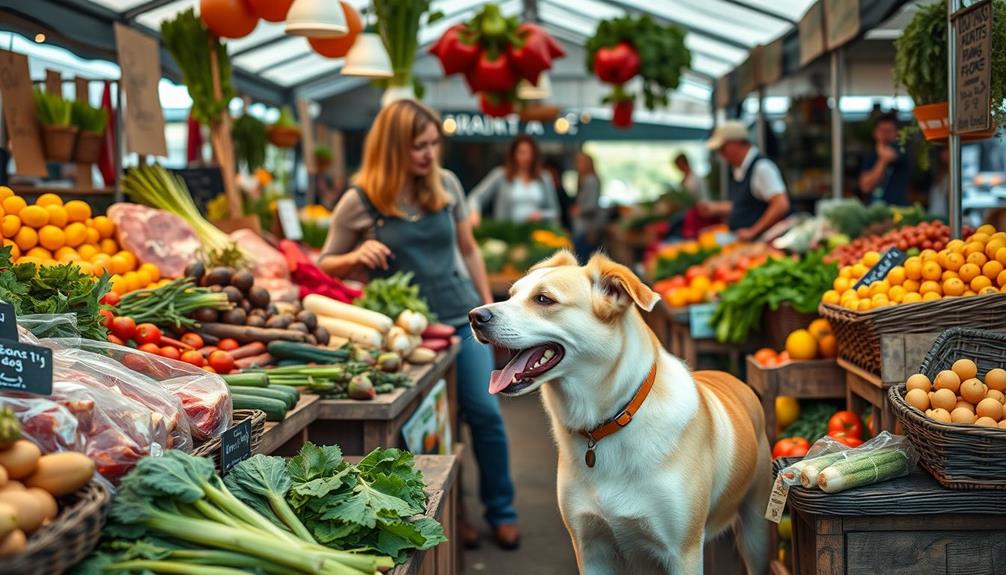
When you support local farmers, you're not just getting fresher, organic meat options for your dog; you're also boosting your community's economy.
These farmers often raise their animals humanely and offer direct sales, giving you the chance to build relationships and customize your orders.
Additionally, sourcing locally can help you discover easy composting methods that utilize food scraps, promoting a sustainable lifestyle while enhancing your dog's raw diet.
Plus, you can find seasonal produce to enhance your dog's raw diet, ensuring they get the best nutrition possible.
Supporting Local Economies
Frequently supporting local farmers when purchasing raw dog food can greatly benefit both your pet and the community.
By choosing local sources, you're not only providing high-quality nutrition for your dog but also contributing to supporting local economies. This approach mirrors the influence of Hopi culture on contemporary practices, emphasizing the importance of local engagement and sustainability.
Here are some advantages you gain by sourcing raw pet food from local farmers:
- Fresher Options: Local farmers often offer fresher, higher-quality meat options like grass-fed beef and ethically raised meat products.
- Cost-Effective: Buying in bulk can lead to significant savings compared to traditional grocery stores.
- Diverse Diet: Many farmers sell less popular organ meats at reduced prices, allowing you to provide a varied diet for your dog without overspending.
- Direct Relationships: Establishing connections with local farmers can enhance sourcing options, ensuring a steady supply of ethically raised meat products.
Fresh, Organic Options
Sourcing fresh, organic options from local farmers can dramatically improve your dog's raw diet. By choosing to buy directly from local farms, you gain access to high-quality, humanely raised meats that enhance your pet's nutritional intake. Plus, many farmers offer unique organ meats at reduced prices, allowing you to create a balanced raw diet without breaking the bank.
Buying in bulk from local farms not only supports your community but also results in substantial savings compared to retail prices. You can often find fresh fruits and vegetables alongside meats, ensuring your dog enjoys a well-rounded diet filled with essential nutrients. Engaging with local agricultural markets can reveal unique protein sources that you won't find in traditional pet food stores.
Here's a quick comparison of benefits you can enjoy:
| Benefit | Description |
|---|---|
| Fresh, Organic Meats | High-quality meats directly from local farms. |
| Unique Organ Meats | Access to less popular organ meats at lower prices. |
| Fresh Fruits & Vegetables | A variety of local produce to complement the diet. |
| Community Support | Strengthens the local economy and promotes sustainability. |
Embrace the freshness of local farms for your dog's health!
Online Retailers and Delivery Services
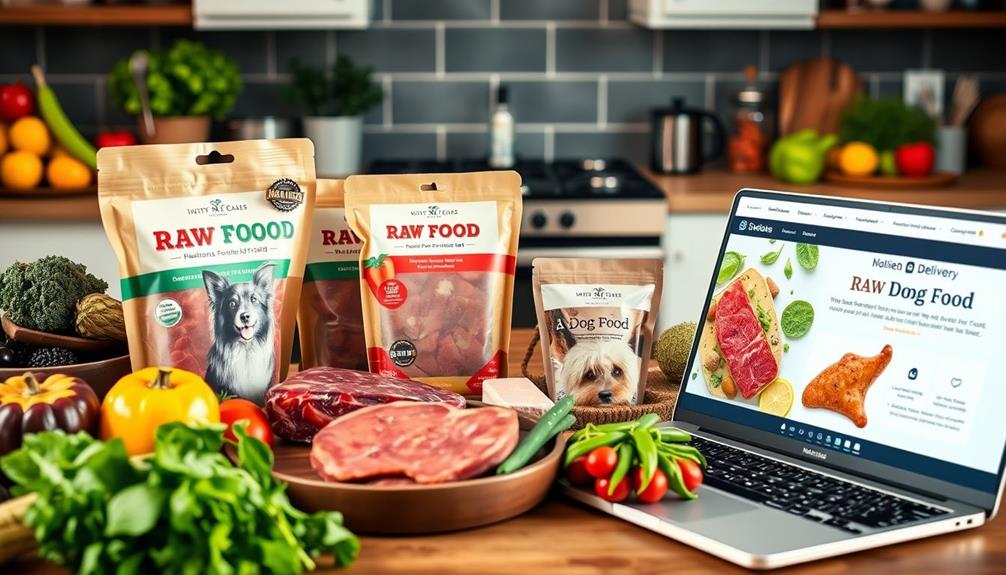
When you choose online retailers for raw dog food, you gain the convenience of home delivery right to your door. This is particularly beneficial for busy pet owners who may struggle to find time for shopping.
Subscription services make it even easier, ensuring your pup gets the nourishment they need without the hassle of frequent trips to the store. Plus, you'll find a wider variety of products than most local shops offer, giving you more options to cater to your dog's specific dietary needs.
Additionally, maintaining a budget for pet supplies is essential, as unforeseen expenses can quickly add up. Keeping track of your spending on budgeting essentials can help you provide the best for your furry friend without breaking the bank.
Convenience of Home Delivery
How easy is it to keep your dog's diet raw and fresh? With the convenience of home delivery, it's simpler than ever. You can order raw dog food from various online retailers, guaranteeing your furry friend gets the best nutrition without the hassle of frequent shopping trips.
Many of these platforms feature best websites to earn money online that not only cater to pet owners but also provide opportunities for those looking to supplement their income while managing their pet care.
Here's what you can expect:
- Wide Variety: Access to numerous brands and types of raw dog food tailored for your pet's needs.
- Nutritional Guidance: Detailed information on feeding guidelines helps you make informed choices.
- Free Shipping: Many retailers offer free shipping on orders over a certain amount, making it cost-effective to buy in bulk.
- Eco-Friendly Packaging: Delivery services use sustainable packaging, keeping your food fresh and reducing environmental impact.
With these features, you can easily maintain a raw diet for your dog while enjoying the benefits of convenience.
Forget about the time wasted at the store; instead, you can focus on quality time with your furry companion. Home delivery guarantees that your dog's meals arrive promptly, fresh, and ready to serve.
Subscription Service Benefits
With the convenience of home delivery already making it easier to provide your dog with raw food, subscription services take it a step further. These services offer flexible delivery schedules, allowing you to receive raw dog food exactly when you need it, ensuring your pup always gets consistent nutrition.
You'll appreciate the various portion sizes available, like 8 oz, 1 lb, and 3 lb options, making it easier to manage feeding for dogs of different sizes. Additionally, providing a diet rich in nutrients can support your dog's overall health and well-being, much like how cranberry juice consumption may benefit humans with its antioxidants.
Many subscription services also provide exclusive products or flavors you won't find in stores, enhancing your dog's meal variety. Plus, you can often enjoy free shipping on larger orders, with some retailers offering this perk for purchases over $249. This makes bulk buying more cost-effective, so you can stock up without breaking the bank.
Another great benefit is the loyalty programs that many subscription services feature. These reward you for your regular purchases, allowing you to earn points that can be redeemed for discounts on future orders.
With these advantages, subscription services streamline the process of providing your dog with high-quality raw food while saving you time and money.
Variety of Product Options
Finding the right raw food for your dog has never been easier, thanks to the wide range of options available from online retailers and delivery services. You can explore various product options tailored to your dog's dietary needs without leaving home.
Additionally, many of these retailers offer unique flavor profiles in their raw food selections, similar to the variety found in coffee numerous varieties available. Here are some enticing choices you'll find:
- Freeze-Dried Meals: Convenient and nutrient-rich, perfect for busy pet owners.
- Single-Protein Options: Great for dogs with food sensitivities, ensuring a limited ingredient diet.
- Complete Raw Diets: Balanced meals that provide all the essential nutrients your dog needs.
- Customizable Subscription Services: Regular deliveries tailored to your dog's specific preferences and dietary requirements.
Many online retailers specialize in raw dog food, offering broader selections than local stores.
You'll often find detailed nutritional information and feeding guidelines to help you make informed choices. Plus, with free shipping options for larger orders, stocking up on your dog's favorite meals becomes economical.
Raw Feeding Co-ops and Groups
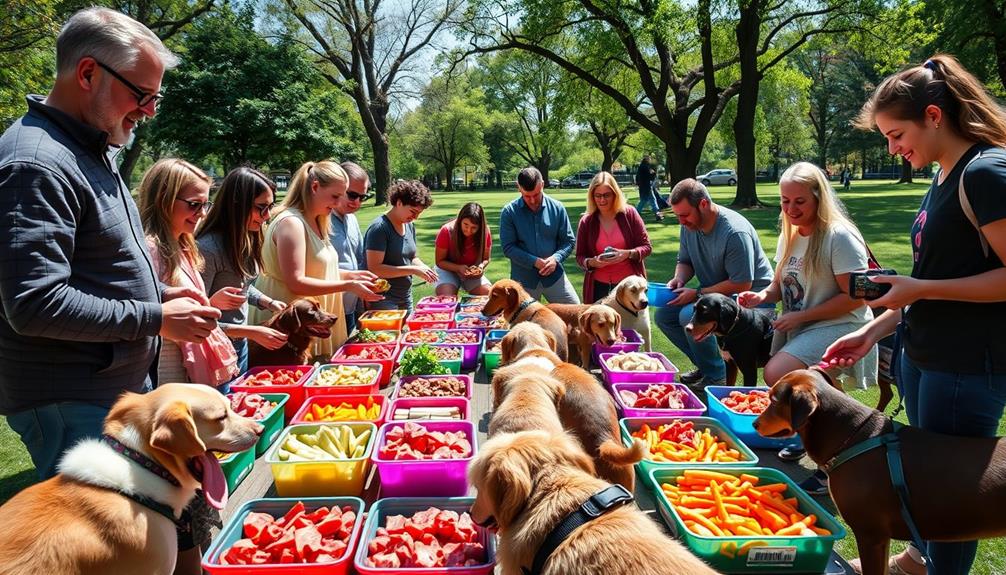
Raw feeding co-ops and groups are a fantastic way for dog owners to connect while benefiting from cost savings. By pooling resources, you can take advantage of bulk purchasing, which leads to lower prices for high-quality meat and organs needed for raw dog food.
These co-ops not only make it easier to source your dog's food but also provide a community where you can share tips and experiences related to raw feeding. Engaging with fellow dog owners can also enhance your understanding of proper nutrition, ensuring your pet's dietary needs are met thoroughly, similar to how proper care is essential for hamsters and other pets ultimate hamster care guide.
Most co-ops focus on ethically sourced, locally produced options, which supports local farms and reduces transportation costs. This means you can feel good about what you're feeding your dog while also getting access to unique proteins and organ meats that may not be available through standard retailers.
Participating in a co-op simplifies the ordering and delivery process, ensuring you have a consistent supply of the raw food your dog needs to thrive.
Plus, you'll discover the health benefits that come with a varied diet rich in meat and organs. Joining a raw feeding co-op is a smart move for both your wallet and your pup's health!
Frequently Asked Questions
What Is the Best Raw Food to Feed My Dog?
To find the best raw food for your dog, look for high protein content, ideally over 40%. Brands like Stella & Chewy's, Maev, and We Feed Raw offer excellent options that support your dog's health.
How to Source Raw Food for Dogs?
To source raw food for dogs, check local pet stores, specialty markets, and butchers. Consider joining co-ops for bulk buying, or explore online shops for convenience and variety. You'll find plenty of options!
What Is the Cheapest Way to Feed My Dog Raw?
To feed your dog raw on a budget, consider buying in bulk from local farmers, joining co-ops, exploring grocery store sections for organ meats, or sourcing low-cost meat through community boards and social media.
Can I Feed My Dog Raw From the Grocery Store?
You might worry about quality, but you can absolutely feed your dog raw food from grocery stores. Just check for freshness, avoid additives, and explore the meat sections for nutrient-rich options like organ meats.
Conclusion
Choosing the right sources for raw dog food can be a delightful adventure. Whether you're exploring local pet stores, chatting with friendly butchers, or browsing online, there's a treasure trove of options waiting for you. Connecting with local farmers or joining raw feeding co-ops adds a sprinkle of community spirit to the mix. With a little effort, you can guarantee your furry friend gets the best nutrition while enjoying the journey of discovery together!

